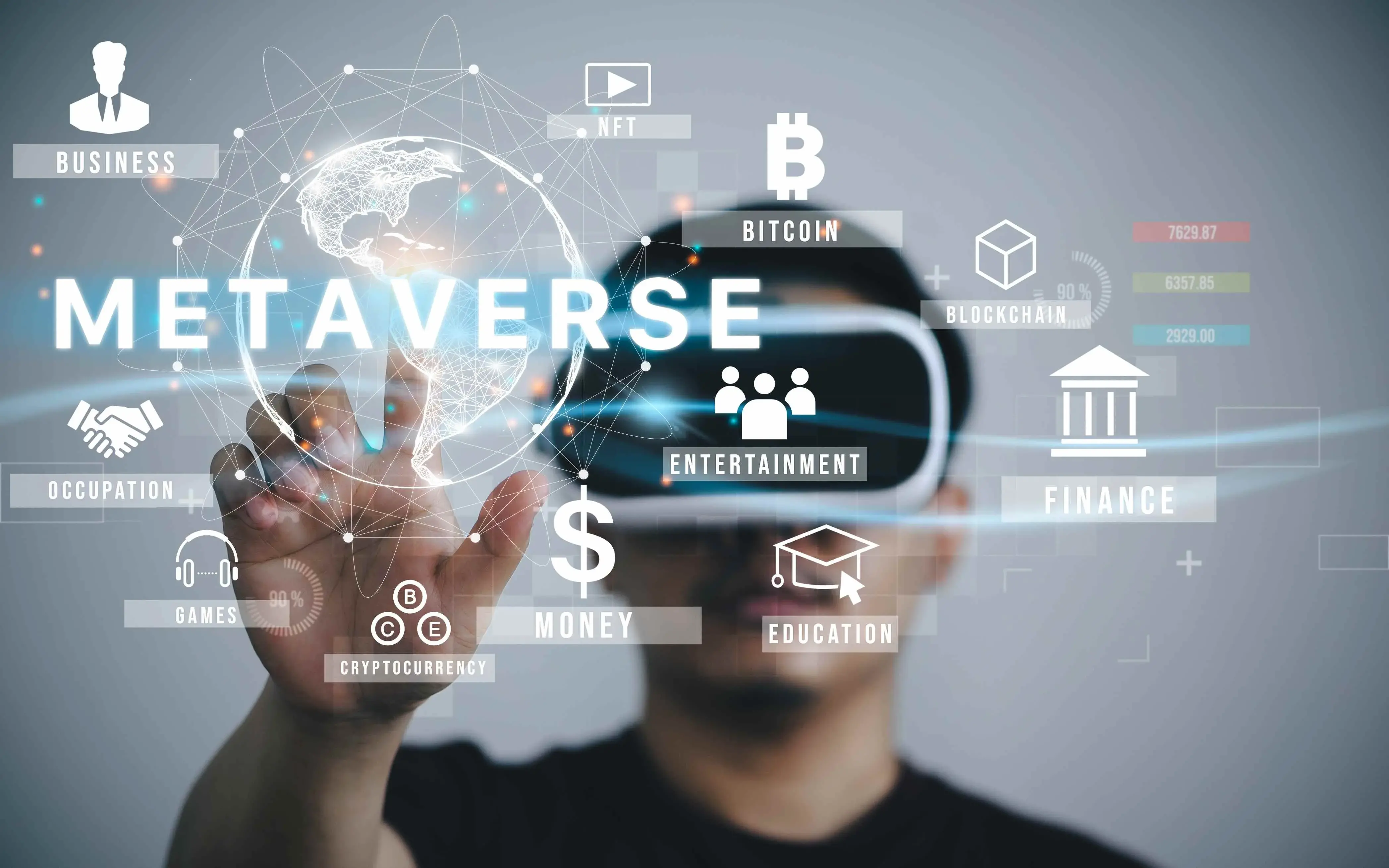The metaverse, a tangible part of our digital reality, extends beyond fiction, intertwining with technological innovation. It serves as a virtual universe where users engage with computer-generated environments in real-time, utilizing augmented reality (AR) and virtual reality (VR) for immersive experiences.
Originally rooted in science fiction, the metaverse has evolved due to technological advancements, transitioning from speculative ideas to a tangible reality. The integration of virtual reality, augmented reality, and interconnected digital platforms have expanded the metaverse beyond its initial fictional boundaries.
Significant in the digital landscape, the metaverse introduces a new dimension for human interaction, creativity, and business. It fosters innovative communication, collaboration, and entertainment, transcending geographical boundaries and influencing various industries, from gaming to commerce.
The metaverse and e-commerce intersect promisingly. Virtual storefronts, powered by AR and VR technologies, offer immersive shopping experiences, allowing users to interact with products virtually before making purchases. This convergence marks a paradigm shift in online transactions, presenting novel ways to browse, shop, and engage with brands in a digital environment.
Understanding the Metaverse

The metaverse is a collective, immersive virtual space where users engage with each other and digital environments in real-time, transcending traditional online experiences. It blends physical and virtual realities seamlessly, forming a dynamic ecosystem.
Key to this experience are Virtual Reality (VR) and Augmented Reality (AR). VR builds immersive 3D environments, and AR adds digital elements to the real world. Together, they make user interactions in the metaverse realistic and interactive.
Technological Components
Virtual Reality (VR) and Augmented Reality (AR): VR immerses users in computer-generated environments, often requiring specialized hardware like VR headsets, while AR enhances the real-world environment by superimposing digital elements, typically accessible through devices like smartphones or AR glasses.
Blockchain Technology: Blockchain ensures secure, transparent, and decentralized transactions within the metaverse, playing a crucial role in establishing trust, enabling ownership verification, and facilitating secure digital interactions.
Non-Fungible Tokens (NFTs): NFTs represent unique digital assets or items within the metaverse. They utilize blockchain technology to establish ownership and authenticity, creating a market for digital collectibles and unique virtual items.
User Experience within the Metaverse
Immersive 3D Environments: In the metaverse, users explore immersive 3D environments, experiencing a heightened sense of presence. Thanks to VR technologies, the experience becomes fully immersive, letting users move around virtual spaces as if they were physically present.
Social Interactions and Communities: The metaverse fosters social interactions and communities, allowing users to connect, collaborate, and communicate in real-time. Users can attend virtual events, participate in shared activities, and build communities based on shared interests.
E-Commerce Elements in the Metaverse
Virtual Storefronts: In the metaverse, traditional brick-and-mortar stores transform into virtual storefronts. These digital spaces offer immersive 3D shopping experiences, providing users with a dynamic and visually rich environment to explore and interact with products.
Digital Assets and NFTs: NFTs are pivotal in representing digital ownership within the metaverse. These tokens, built on blockchain technology, enable the creation and trade of unique digital assets. NFT integration bridges the gap between the physical and virtual worlds, unlocking new possibilities for creativity and commerce.
Decentralized Commerce: Decentralized commerce in the metaverse reduces the risk of fraud and enhances trust in the virtual marketplace. Transactions, facilitated by blockchain technology, operate in a decentralized nature, ensuring transparency and security. This lays the foundation for a new era of commerce characterised by increased reliability and efficiency.
Social Shopping: Social shopping in the metaverse introduces collaborative and interactive elements. Users can engage in shared shopping experiences, attend virtual events, and collaborate with others in real time. This social dimension enhances the overall e-commerce experience, making it more communal and engaging.
Virtual Payment Systems: The metaverse witnesses the rise of digital currencies, with cryptocurrencies leading the way. Virtual payment systems enable borderless transactions, offering a seamless and secure method for users to conduct transactions within the metaverse.
Personalized AI-driven Experiences: Artificial Intelligence (AI) algorithms play a crucial role in analyzing user behaviour within the metaverse. This analysis enables the delivery of personalized and enjoyable shopping journeys, tailoring recommendations and interactions to individual preferences.
Challenges and Opportunities in the Metaverse
Navigating the metaverse presents both challenges and opportunities, shaping the future of digital experiences.
Challenges
Privacy Concerns: Tracking user behaviour in virtual spaces raises privacy concerns. Striking a balance between personalization and privacy is crucial. Users should have control over the data shared, emphasizing the need for transparent data policies and user consent mechanisms.
Security Issues: Secure transactions are paramount in the Metaverse. Auditing smart contracts is essential to identify and rectify vulnerabilities. Ensuring the integrity of financial transactions and protecting user data is vital for building trust in the virtual commerce ecosystem.
Standardization: Lack of standardization across virtual platforms hinders seamless integration. Establishing industry standards in virtual commerce is essential for interoperability and a consistent user experience. Standardization can promote a more cohesive and interconnected metaverse.
Accessibility: Ensuring inclusivity for individuals with disabilities is a priority. Features for a universally accessible metaverse, such as voice commands, screen readers, and other assistive technologies, must be implemented. This fosters an environment where everyone can participate in and benefit from virtual experiences.
Content Regulation: Balancing freedom of expression with the need for responsible content regulation is a challenge in the metaverse, as it becomes a shared space for various forms of expression.
Opportunities
Global Reach: The metaverse provides an opportunity for businesses to expand their reach globally, reaching a diverse and interconnected audience. Virtual storefronts can cater to customers worldwide, transcending geographical boundaries.
New Revenue Streams: Virtual commerce in the metaverse opens up new revenue streams. From virtual goods and services to unique digital assets, businesses can explore innovative ways to monetize their offerings and create value for users.
Immersive Education: The metaverse presents a platform for immersive and interactive educational experiences, revolutionizing traditional learning methods.
Virtual Commerce: E-commerce within the metaverse introduces novel ways for users to explore, interact, and purchase products, creating a unique and engaging shopping experience.
Environmental Impact of Metaverse Technologies

It is essential for stakeholders in the metaverse industry, including technology developers, platform operators, and users, to be mindful of these environmental considerations. Balancing the rapid advancements in immersive technologies with sustainable practices will be crucial for the long-term viability and acceptance of the metaverse.
Energy Consumption
- Hardware Requirements: Virtual reality (VR) and augmented reality (AR) devices, such as headsets, often demand significant computing power. High-performance hardware requires more energy for production and operation.
- Data Centers: The infrastructure supporting metaverse platforms, including data centers, contribute to energy consumption. The processing and storage demands for immersive experiences can result in substantial electricity usage.
Carbon Footprint
- Digital Transactions: Blockchain technology and the use of non-fungible tokens (NFTs) within the metaverse can involve significant computational work, contributing to carbon emissions. This is particularly relevant in proof-of-work blockchain systems.
- Data Transfer: Real-time interactions in the metaverse involve constant data transfer between users and servers, leading to carbon emissions associated with internet infrastructure.
Electronic Waste
The rapid evolution of metaverse technologies may lead to the disposal of outdated devices, contributing to electronic waste. Proper recycling and disposal practices become crucial to mitigate environmental impact.
Sustainability Measures
- Green Computing: There is a growing emphasis on developing energy-efficient hardware and data center solutions. Green computing initiatives aim to reduce the environmental footprint of digital technologies.
- Renewable Energy: Some companies are investing in or committing to using renewable energy sources to power data centers and offset the carbon footprint associated with metaverse technologies.
Public Awareness and Responsibility
- Consumer Awareness: Educating users about the environmental impact of metaverse technologies can lead to more responsible consumption and a demand for eco-friendly practices.
- Corporate Responsibility: Companies involved in the development of metaverse technologies can adopt environmentally friendly policies and practices, contributing to a more sustainable industry.
The Future of E-Commerce in the Metaverse
Enhanced User Engagement
In the metaverse, e-commerce will offer enhanced user engagement through dynamic and interactive virtual environments. Users can immerse themselves in personalized and interactive shopping experiences, fostering a deeper connection between consumers and brands.
New Revenue Streams
The introduction of NFTs and digital assets in e-commerce within the metaverse opens up new revenue streams. Businesses can engage in the creation and sale of virtual items, limited-edition products, and unique digital assets, providing users with exclusive and collectible offerings.
Global Reach
The metaverse eliminates geographical boundaries in cross-border trade, allowing businesses to reach a global audience. Virtual storefronts provide opportunities for international expansion, connecting businesses with consumers worldwide.
Evolution of Retail
The future of e-commerce in the metaverse involves redefining traditional notions of retail. The seamless blend of online and offline experiences creates a dynamic shopping environment where users can explore virtual storefronts, try on virtual products, and make purchases in a visually rich and immersive space.
Community Building
E-commerce in the metaverse will focus on fostering communities. Businesses can connect users with shared interests and experiences, creating a sense of belonging within the virtual space. Virtual events and shared activities contribute to the development of vibrant and engaged communities.
Conclusion
Navigating the evolving metaverse involves considering technological progress, user adoption, and regulatory factors. Exploring the future of e-commerce within this digital space, virtual storefronts redefine shopping with immersive 3D experiences, bridging physical and virtual worlds. The integration of digital assets and NFTs introduces unique revenue streams, emphasizing the exclusivity of virtual items and expanding businesses' global reach.
Despite these opportunities, challenges such as privacy concerns, security issues, and the lack of standardization require careful attention and proactive solutions. Achieving a balance between personalization and privacy, ensuring secure transactions, and establishing industry standards are crucial for building trust and realizing the full potential of metaverse e-commerce.
To fully grasp what metaverse offers, delve deeper into this transformative shift. Explore how it reshapes shopping, connectivity, and commerce, as understanding these changes is key to harnessing its benefits and embracing the future of digital experiences.
Frequently Asked Questions
What are virtual payment systems in the Metaverse?
In the Metaverse, virtual payment systems are digital transaction methods specifically designed for the virtual environment. Cryptocurrencies, such as Bitcoin Ethereum, and other virtual currencies facilitate seamless and secure transactions within the Metaverse, eliminating the need for traditional payment methods.
How do AI-driven personalized experiences enhance virtual shopping?
AI-driven personalized experiences in virtual shopping leverage algorithms to analyze user behaviour. This analysis enables tailored product recommendations, personalized advertisements, and a more enjoyable shopping journey, mimicking the level of personalization one might experience in a physical store.
How are virtual storefronts different from traditional online shopping?
Virtual storefronts in the Metaverse differ from traditional online shopping by offering immersive 3D environments. Users can explore these digital spaces, interact with products in real-time, and enjoy a more dynamic and visually engaging experience compared to the two-dimensional interfaces of traditional online platforms.
What is an example of VR in eCommerce?
An example of VR in e-commerce is the use of virtual reality technology to create immersive product experiences. For instance, customers can virtually try on clothing or explore the features of a product in a three-dimensional space before making a purchase decision.
How can retailers use the metaverse?
Retailers can use the Metaverse to establish virtual storefronts, engage customers through immersive experiences, offer exclusive virtual items and limited-edition products, and build communities with shared interests. The Metaverse provides an opportunity for retailers to redefine and expand their digital presence.
Is Meta a Metaverse?
Meta, formerly known as Facebook, is a company that is actively investing in and working towards building the Metaverse. Meta is positioning itself to be a significant player in the development and shaping of the Metaverse, although the term "Meta" is also used to refer to the broader concept of the Metaverse.
How secure are transactions in the Metaverse, especially with the integration of blockchain?
Transactions in the Metaverse, particularly with the integration of blockchain, can be highly secure. Blockchain technology ensures transparency and decentralization, reducing the risk of fraud. Smart contracts audit and secure transactions, providing a foundation for trust and security within the virtual commerce ecosystem.
How do virtual storefronts impact the traditional retail landscape?
Virtual storefronts impact the traditional retail landscape by offering a new dimension to consumer experiences. While traditional retail remains essential, virtual storefronts provide an additional channel for retailers to engage customers, showcase products, and create immersive shopping experiences, ultimately influencing the evolution of retail practices.

Yetunde Salami is a seasoned technical writer with expertise in the hosting industry. With 8 years of experience in the field, she has a deep understanding of complex technical concepts and the ability to communicate them clearly and concisely to a wide range of audiences. At Verpex Hosting, she is responsible for writing blog posts, knowledgebase articles, and other resources that help customers understand and use the company's products and services. When she is not writing, Yetunde is an avid reader of romance novels and enjoys fine dining.
View all posts by Yetunde Salami




















